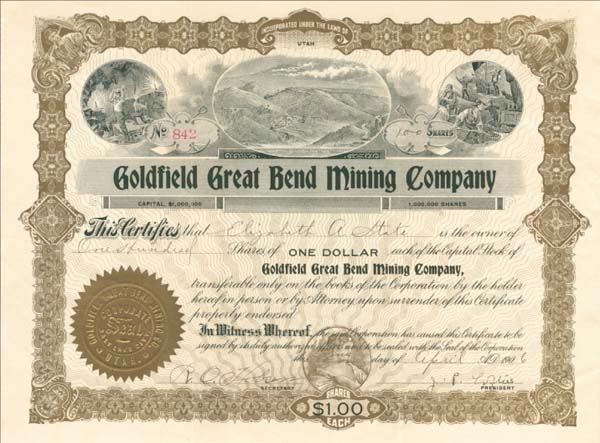Goldfield Great Bend Mining Co. - Stock Certificate
Inv# MS1391 Stock
State(s):
Utah
Years:
1906-07
Stock printed by Goes. The Diamondfield Mining & Milling Co. of Nevada and the Goldfield Great Bend Mining Company merged to form the Great Bend Company in 1915.
GOLDFIELD GREAT BEND MINING CO. NEVADA
Office: 302 News Bldg., Goldfield. Nev.
Officers: C. S. Sprague, pres.; J. K. Turner, v. p.; Ben Gill, sec.-treas., with L. L. Dellinger and B. W. Ward, directors.
Inc. May 8, 1915, in Nevada. Cap., $1,500,000; shares $1 par; assessable; all outstanding. Assessment No. 5. of lOc. per share, levied January, 1919. Stock listed on San Francisco Exchange.
Financial statement for period February, 1916, April, 1918, shows: total receipts. $90,214, including sale of 30.040 treasury shares, $1,502; assessment No. 2, $14,498; assessment No. 3, $14.575; ore sales, $59,346. Expenditures for same period amounted to $84,875. Report for 9 months ending January 1. 1919. shows: receipts, $24,731, including $14,781 from assessment No. 4. and $3,293 from ore sales. From January to July, inclusive, income was $16,880. and expenses, $13,610; accounts and bills payable were $4,901.
Property: 7 patented claims, 112 acres, in Diamondfield section of Goldfield, Esmeralda county. Claims show a quartz vein in andesite. with 28* dip and E.-W. course. Oxide and sulphide ores occur in shoots said to average $60 per ton. Development: by shafts to 50&. The mine was unwatered and GOLDFIELD MERGER—GRANDMA 1193
underground work begun in 1915. A drift is being driven E. from the 375' level of the main shaft toward the Lockhart shaft to intersect the downward extension of oreshoots exposed on the 236' level. From February, 1916, to April, 1918, 4,633' of new work was done at a cost of $54,579 or $11.78 per foot; 931' of new work done in 1918 cost $19 per foot, and 655' of new work in 1919 cost $14.11 per foot.
Equipment: 75-h. p. hoist, compressor, pump and an old mill which will probably be re-built.
Production: (net) in 1916 (4 months). 106 tons, yielding $3,168; in 1917, 1,800 tons, yielding $46,533; in 1918, 715 tons, yielding $12,937, a total production of 2,621 dry tons. Operations to April, 1918, showed an operating loss of $25,529. First seven months of 1919 yielded 85 tons of $21.48 ore.
Condition:
Excellent
A stock certificate is issued by businesses, usually companies. A stock is part of the permanent finance of a business. Normally, they are never repaid, and the investor can recover his/her money only by selling to another investor. Most stocks, or also called shares, earn dividends, at the business's discretion, depending on how well it has traded. A stockholder or shareholder is a part-owner of the business that issued the stock certificates.
Item ordered may not be exact piece shown. All original and authentic.










Ebay ID: labarre_galleries